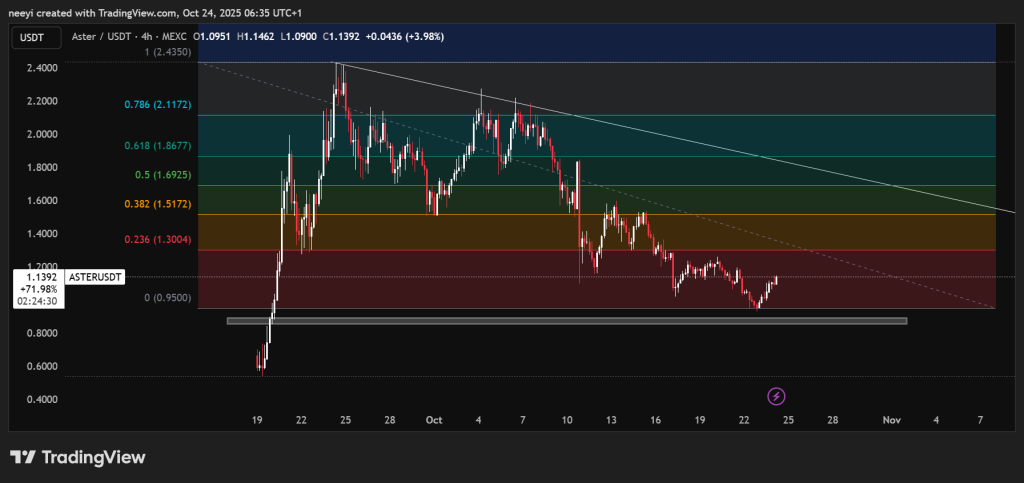
Aster was one of the standout names in September following its launch on several exchanges. ASTER token price shot up quickly, reaching about $2.4 at its peak. For a moment, it looked like it could be one of those rare listings that sustain their early momentum.
At the time, many believed the spike had something to do with utility rather than just listing hype. That assumption didn’t come out of nowhere because ASTER actually serves a purpose.
Aster project is a decentralized exchange (DEX) that merges spot and perpetual futures trading. It aims to make trading both simple and powerful, appealing to beginners with an easy interface while offering advanced tools for professionals. The goal is to bridge the gap between DeFi and traditional derivatives trading, which sounded like a strong reason for optimism when it launched.
For a while, it felt justified to think the Aster price rally was utility-driven. A token that supports a real DEX with staking, fee discounts, and governance rights can often hold value longer than purely speculative coins.
What you'll learn 👉
Why Aster Price Fell Sharply After Its Launch
Despite that promising start, ASTER price couldn’t hold its early gains. From its high around $2.4, it’s dropped nearly 50%, now sitting near $1.14 at the time of writing.
It’s become clear that much of the initial excitement was post-launch hype. As early investors took profit and short-term traders exited, the price corrected sharply. This kind of pattern isn’t unusual for newly listed tokens, especially in a volatile market where enthusiasm fades quickly.
That said, ASTER still has long-term potential. It remains a functioning DEX with a clear roadmap, and several new features could give the token fresh momentum once implemented.
What Aster Chart Suggests Right Now
From a technical perspective, the Aster price tells a cautious but interesting story. After the correction, the token’s movement started to form a descending trendline, which has acted as strong resistance. The price has touched this line at least three times, confirming its validity.
Each time Aster tried to break above, it got rejected and moved lower. However, the good news for short-term traders is that the token seems to have found a support zone between $0.89 and $0.95. The price has already bounced from this level, now trading around $1.14.

If that support continues to hold, a short-term rally could be on the table. A move back toward the descending trendline resistance could translate into a 50–60% price gain from current levels, potentially reaching between $1.6 and $1.8.
Interestingly, these levels also align closely with the 0.5 and 0.618 Fibonacci retracement zones, which are often seen as key resistance points in technical analysis. The 0.236 ($1.3) and 0.382 ($1.5) levels also mark potential resistance areas where sellers may appear.
So while there’s short-term upside potential, the broader downtrend remains intact until Aster breaks out decisively above its trendline.
Why Some Analysts Still Believe in Aster’s Utility
While technical indicators suggest caution, some analysts still see promise in the Aster ecosystem. One of them, Panke (@Pankekkeku), shared insights on X (formerly Twitter) earlier in October about new token utilities expected soon.
According to him, the Aster CEO, Leonard_Aster, confirmed several features in development that could strengthen the token’s long-term value:
- Fee discounts for users who pay with $ASTER.
- Staking to achieve higher VIP tiers on the DEX, similar to Binance’s Launchpool model, offering reduced fees and extra rewards.
- Governance voting, allowing users to participate in platform decisions.
- Aster Chain rollout, a privacy-preserved Layer-1 network capable of 150k+ TPS, designed for speed and scalability.
- Builder compartments to integrate wallets like Trust Wallet and SafePal.
- Collateral utility, where users can use $ASTER as collateral in the “trade & earn” feature—similar to how stablecoins can be minted using existing crypto assets.
Aster CEO @Leonard_Aster on NEW $ASTER token utility that will be ADDED in the coming WEEKS
— Panke (@Pankekkeku) October 1, 2025
Buy now or cry later, every single utility will pump the price.
1. Use it as fee for discount ✅
2. Staking > for higher vip tier levels on dex = reduced fees + rewards (think… pic.twitter.com/Basi87KfAw
If these features roll out successfully, they could help Aster shift from being a short-term trading asset to a long-term utility token within its ecosystem.
Should You Consider Buying Aster Now?
Whether Aster is worth buying again depends on your goal. For short-term traders looking for quick profits, there’s a potential opportunity if the price bounces toward the descending trendline resistance. That move alone could yield a 50–60% gain before any major rejection.
However, for long-term holders, caution is still wise. The token hasn’t confirmed a full reversal yet, and its current recovery could still be part of a larger downtrend. Waiting for a confirmed breakout above resistance levels might be a more secure entry point.
Read Also: Here’s What Happens to Zcash (ZEC) Price If Bulls Don’t Hold This Level
That said, if you believe in Aster’s roadmap and the upcoming utility features, accumulating gradually at lower levels could make sense. The combination of new use cases, improved liquidity, and strong technical structure might eventually bring back investor confidence.
Subscribe to our YouTube channel for daily crypto updates, market insights, and expert analysis.








